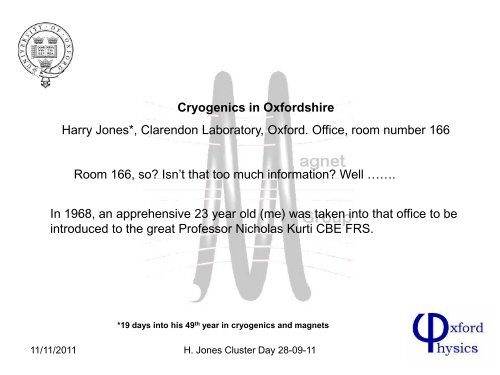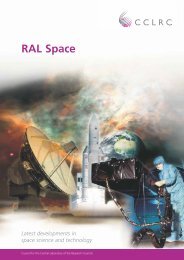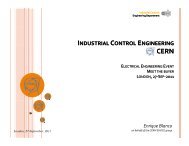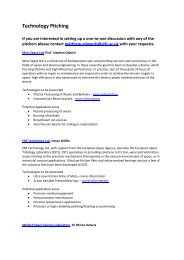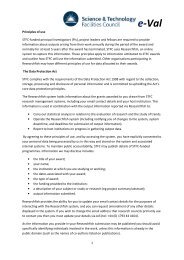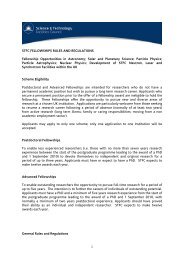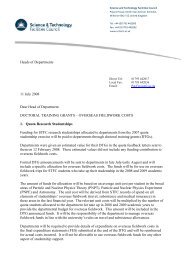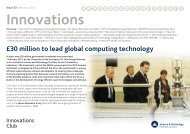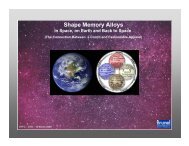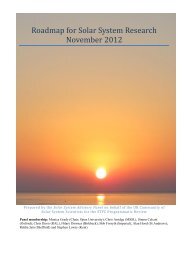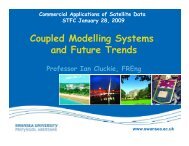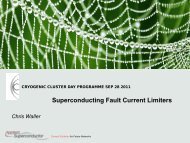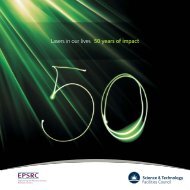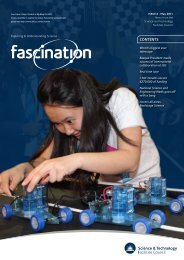Cryogenics in Oxfordshire Harry Jones*, Clarendon Laboratory ...
Cryogenics in Oxfordshire Harry Jones*, Clarendon Laboratory ...
Cryogenics in Oxfordshire Harry Jones*, Clarendon Laboratory ...
Create successful ePaper yourself
Turn your PDF publications into a flip-book with our unique Google optimized e-Paper software.
<strong>Cryogenics</strong> <strong>in</strong> <strong>Oxfordshire</strong><br />
<strong>Harry</strong> <strong>Jones*</strong>, <strong>Clarendon</strong> <strong>Laboratory</strong>, Oxford. Office, room number 166<br />
Room 166, so? Isn’t that too much <strong>in</strong>formation? Well …….<br />
In 1968, an apprehensive 23 year old (me) was taken <strong>in</strong>to that office to be<br />
<strong>in</strong>troduced to the great Professor Nicholas Kurti CBE FRS.<br />
*19 days <strong>in</strong>to his 49 th year <strong>in</strong> cryogenics and magnets<br />
11/11/2011 H. Jones Cluster Day 28-09-11 1
In effect, we have to thank Adolf Hitler for cryogenics <strong>in</strong> <strong>Oxfordshire</strong><br />
And<br />
Frederick L<strong>in</strong>demann (later Lord Cherwell) Head of the <strong>Clarendon</strong><br />
<strong>Laboratory</strong>.<br />
Anti Semitism <strong>in</strong> Germany <strong>in</strong> the 1930s was rife. This gave L<strong>in</strong>demann<br />
the idea to offer refuge to top quality Jewish physicists especially<br />
those who worked <strong>in</strong> the area of low temperatures. The result: Franz<br />
(later Sir Francis) Simon, Kurt Mendelssohn, He<strong>in</strong>rich Kuhn and ……...<br />
11/11/2011 H. Jones Cluster Day 28-09-11 2
Nicholas Kurti who had been Simon’s student and post doc<br />
<strong>in</strong> Berl<strong>in</strong> and Breslau (now Wroclaw, Poland).<br />
“<br />
”<br />
11/11/2011 H. Jones Cluster Day 28-09-11 3
Low temperature work really took off <strong>in</strong> the <strong>Clarendon</strong> laboratory <strong>in</strong><br />
the 1930s<br />
As did magnetic fields. We all know, now, that magnets need low<br />
temperatures – liquid helium etc, but these were the days before<br />
superconduct<strong>in</strong>g magnets (although Mendelssohn was writ<strong>in</strong>g to<br />
Nature suggest<strong>in</strong>g superconduct<strong>in</strong>g PbBi wire magnets as long ago as<br />
1933).<br />
Back then, it was the other way round. High magnetic fields were<br />
needed to get low temperatures, i.e., adiabatic demagnetisation<br />
of paramagnetic salts. Hence the famous 2 MW ex tramways<br />
generator that allowed fields up to 12.5 T <strong>in</strong> the <strong>Clarendon</strong><br />
By 1956 Kurti achieved a millionth of a degree kelv<strong>in</strong> us<strong>in</strong>g<br />
nuclear demagnetisation and Parks Road Oxford was the<br />
coldest spot on earth. In 1960 Kurti repeated the experiment<br />
on live television (Tomorrow’s World) and the record stood for<br />
18 years (see Gu<strong>in</strong>ness Book of Records!)<br />
11/11/2011 H. Jones Cluster Day 28-09-11 4
The legacy of all this seeped <strong>in</strong>to <strong>Oxfordshire</strong> – and elsewhere.<br />
•Oxford Instruments, the university’s first sp<strong>in</strong> out company was founded – See<br />
Audrey’s excellent book “Magnetic Venture”<br />
•Another <strong>Clarendon</strong> Man, Jeremy Good (Mendelssohn’s student), founded a<br />
company called, Cryogenic<br />
•Mendelssohn founded the journal “<strong>Cryogenics</strong>” <strong>in</strong> Oxford<br />
•Yet another <strong>Clarendon</strong> man, Ralph Scurlock, founded the Institute of<br />
<strong>Cryogenics</strong> <strong>in</strong> Southampton<br />
•Kurti was a co-founder of the British <strong>Cryogenics</strong> Council (its current chairman<br />
is a <strong>Clarendon</strong> man …..)<br />
•John Cosier and Mike Glazer (both <strong>Clarendon</strong> men) founded Oxford<br />
Cryosystems (Long Hanborough)<br />
•He<strong>in</strong>z London proposed the 3 He/ 4 He dilution refrigerator at a conference <strong>in</strong> the<br />
<strong>Clarendon</strong> “The Harwell fridge” that was developed by OI.<br />
•And, of course, Harwell, RAL (or NIRNS as was) and Culham (the famous<br />
Goodall chart) were all strong centres of cryogenics. Although, until 1974, they<br />
were <strong>in</strong> Berkshire NOT <strong>Oxfordshire</strong>.<br />
I’m sure there’s lots I’ve forgotten / didn’t know <strong>in</strong> the first place.<br />
You might call the above “direct impact”………………<br />
11/11/2011 H. Jones Cluster Day 28-09-11 5
How did th<strong>in</strong>gs spread ?<br />
This is not <strong>in</strong> chronological order<br />
•After OI, other “cryogenic” companies formed sometimes from OI<br />
•Thor <strong>Cryogenics</strong> Magnex (ElSc<strong>in</strong>t) - Berensfield<br />
•Technology Systems (brief but existed) - Witney<br />
•AS Scientific – Ab<strong>in</strong>gdon<br />
•OMT (Eynsham) morphed <strong>in</strong>to Siemens Magnet Technology (SMT)<br />
•Thames <strong>Cryogenics</strong> - Didcot<br />
•Scientific Magnetics (previously Space Cryomagnetics) - Ab<strong>in</strong>gdon<br />
•ICE Oxford<br />
•Cryophysics - Witney<br />
As previously listed: Cryogenic 1 and Cryosystems<br />
1<br />
Not <strong>in</strong> <strong>Oxfordshire</strong><br />
11/11/2011 H. Jones Cluster Day 28-09-11 6
So, Hitler and the <strong>Clarendon</strong> <strong>Laboratory</strong> have a lot to<br />
answer for. Lots of cryogenics over some 80 years (of the<br />
hundred or so years of LHe and superconductivity) not<br />
exclusively <strong>Oxfordshire</strong> of course but rather Oxford –<br />
centric.<br />
And here we are today, <strong>in</strong> <strong>Oxfordshire</strong> with the Cryogenic<br />
Cluster<br />
CRYOGENIC CLUSTER - The Most Powerful<br />
Concentration of Cryogenic Expertise on<br />
Earth<br />
and<br />
11/11/2011 H. Jones Cluster Day 28-09-11 7


